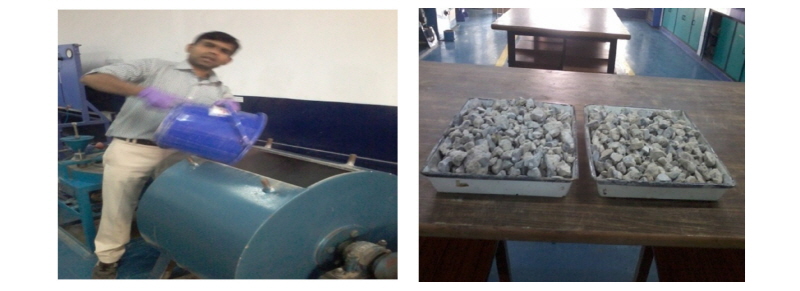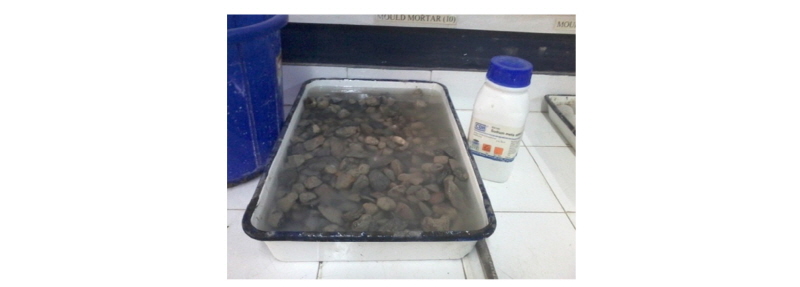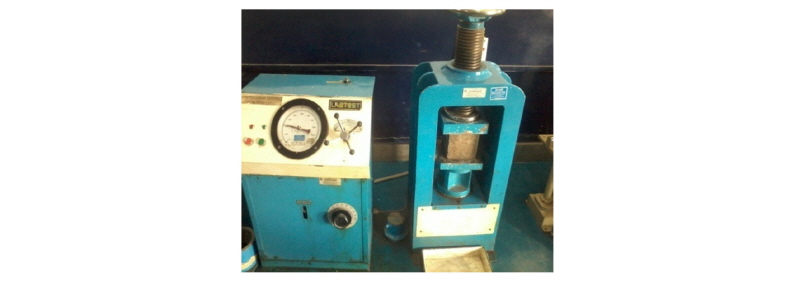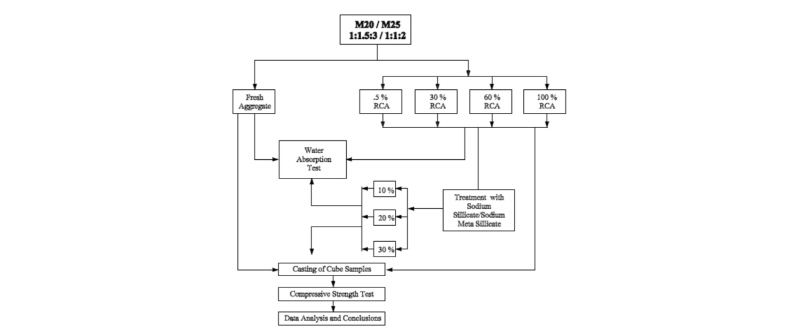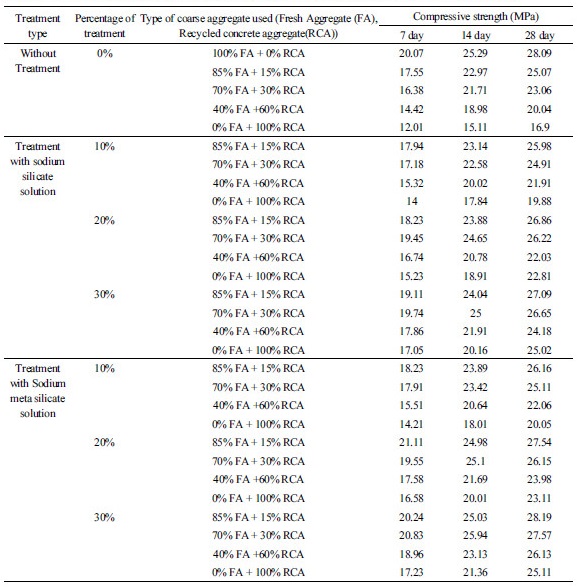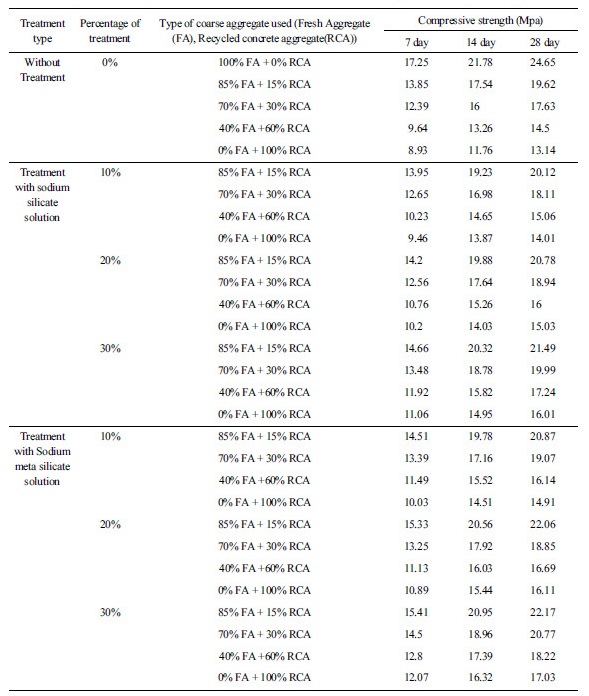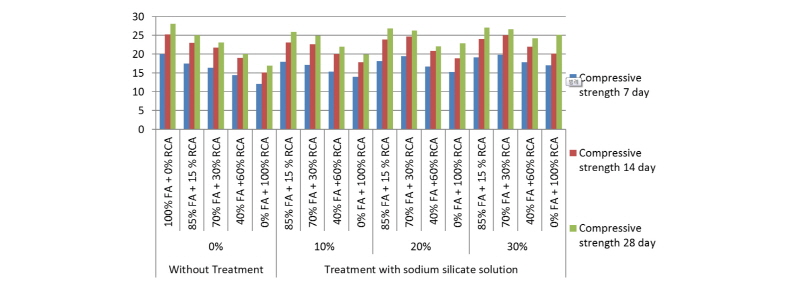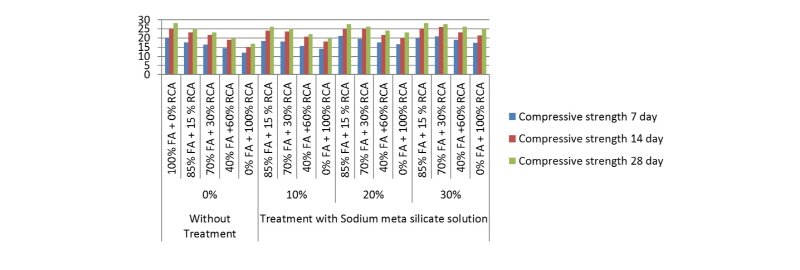Introduction
Materials and Method
Materials
Mix design
Results and Discussions
Water-Cement ratio required for concrete with different aggregate
Conclusions
Introduction
Large scale use of fresh aggregate in road and building construction has depleted the resources of natural aggregate and promoted the use of recycled aggregate concrete (RCA) in construction. Building and road industry is the largest consumer of the aggregate and largest producer of the aggregate waste material. These aggregate waste materials can be used again in road and building construction after proper recycling and treatment. Prior to their application in construction it is essential to study their properties, as aggregate composition and properties have a great influence on the concrete properties [1-2]. Recycling and reuse of RCA can make demolished building wastes, a valuable construction material. Several studies were carried out to evaluate the mechanical and physical properties of the concrete mix made using RCA [3-7].
Several advancements in construction technology has made the construction much easier and less time taking, which has drastically increased the demand for building materials. Also with rapid urbanisation and growth of economy, the living standards have improved. This has led to the demolition of various existing buildings and construction of new structures in their place. This rise in demand of construction has resulted in increase in demand of concrete. Aggregate is the most important constituent of concrete and hence the demand for natural aggregate has drastically increased because of which the natural resources are being tapped.
The extraction of natural aggregate and materials like gravel and sand have modified the landscapes, river course and river bed and causes large scale destruction to site environmental conditions [8].
Demolishing the construction waste creates a major havoc for the environment as a large quantity of construction and demolishing waste goes to land fill sites for disposal. If the demolishing work and disposal continues with this rate, soon there will be shortage of landfill sites and depletion of natural sources of aggregate. A study shows that disposal of approximately 75% of waste materials in European Union countries are carried out in landfills, despite its major recycling potential [9].
Owing to high scale depletion of natural aggregate and accumulation of construction and demolishing waste has led to search for various option of utilization of construction demolished waste (CDW). Also, with the upcoming environmental laws, conservation of natural resources and consciousness among the massive disposal of waste in landfill site is not a viable option. Thus, recycling and reusing the construction and demolishing waste is one of the best use of waste material. The CDW is crushed to the size of natural aggregate and treated with chemical to remove the mortar layer attached to it, to be used as a substitution for natural aggregate. Such substituted particles are known as recycled aggregate and the concrete generated from it is known as recycled aggregate concrete. The recycled aggregate consists of the aggregated surrounded with mortar around. The quantity of mortar largely affects the durability and engineering properties of the concrete. RCA exhibit different characteristics as compare to natural aggregate, as RCA consist of two different type of material i.e., mortar (cement or lime mortar attached to aggregate) and natural aggregate. Attachment of cement mortar in RCA is responsible for its high water absorption capacity, low density and high Los Angeles abrasion [10]
The adhered mortar makes concrete more porous thereby lowering the properties of recycled aggregate concrete as compared to natural aggregate concrete. Recycled aggregate absorb much more water than natural aggregate which is a remarkable difference between the two. Several studies have reported the high water absorption by RCA, which affects its compressive strength [11-15].
The major aim of present study is to evaluate the influence of polymer treatment on RCA and its water absorption capacity and determine strength of M20 and M25 concrete mix designs prepared using RCA with partial or complete replacement of fresh aggregate. The outcome of this study will be helpful in understanding the utility of treatment methods in construction and promoting the utilization of demolished wastes in road and building construction.
Material and Methodology
The strength properties of concrete by replacing different percentages of natural aggregate with recycled concrete aggregate were studied by conducting the compression test on concrete cubes using the compression testing machines. The details of material used and methodology adopted to conduct the study is stated below.
Materials
OPC 53 grade cement (IS 12269-1987) and fly ash were used as the binding material. Table 1 and Table 2 show the physical and chemical properties of OPC 53 grade cement used in the experiments .Natural river sand collected from Yamuna river in Badarpur, New Delhi was used as fine aggregate and crushed gravel collected from Faridabad, Harayana were used as coarse aggregate. The recycled concrete aggregate were collected from a plant in Burari, New Delhi. The properties of aggregate are given in Table 3. Further the RCA were treated with two reagents Sodium Silicate and Sodium Metasilicate to improve its water absorption properties. Therefore, by using these materials concrete of two different grades M20 and M25 with proportions 1:1.5:3 and 1:1:2 respectively were casted.
Methodology
The adopted methodology for RCA research work is illustrated with the help of flow-chart shown in Figure 4. Water absorption test was performed both on fresh and recycled aggregate to determine the required water cement ratio for concrete.
The concrete cubes for M20 and M25 grade were casted without recycled aggregate for comparison studies using Ordinary Portland Cement, fine river sand and fresh aggregate in ratio of 1:1.5:3 and 1:1:2. The water cement ratio was maintained around 0.45 and their compressive strength was estimated for 7, 14 and 28 days of curing.
After this five concrete cubes each for M20 and M25 were casted by replacing 15% fresh aggregate by recycled aggregate and using same binder, aggregate and sand. The recycled aggregate were rotated in the Los angeles abrasion apparatus to remove the excess mortar stuck to it (Figure 1). Water absorption test results shows that the required water cement ratio after 15% replacement is 0.6 due to the attached layer of mortar with recycled aggregate. These samples were then tested in CTM after 28 days of curing (Figure 3). Similarly five cubes each were casted for replacement of 30, 60 and 100% fresh aggregate by recycled aggregate at the required water cement ratio of 0.65, 0.8 and 0.85 respectively.
To improve the strength, recycled aggregate were treated with two polymers namely 'Sodium Silicate’ and ‘Sodium Metasilicate’ for 24 hours at concentration of 10, 20 and 30% (Figure 2) and further used for casting cube samples at 15, 30, 60 and 100% replacement of fresh aggregate.
Result and Discussion
Due to increase in demand of building material in construction industry, search for the alternative material is the need of hour to preserve our natural resources. Hence, using recycled concrete aggregate solves two major problems of safeguarding the natural resources and utilisation of construction demolished waste (CDW). Hence, the study was conducted to check the strength of concrete manufactured with RCA. The results for the test conducted are tabulated below:
Water-Cement ratio required for concrete with different aggregate
The concrete manufactured was such that the slump value for it was maintained as 100 mm thus the water/ cement ratio required to cast M20 and M25 concrete cubes with fresh aggregate and with recycled aggregate, with and without treatment was found out using the slump cone test. The results for different concrete sample are tabulated below in Tables 4 to 7. The bar chart illustrates (Figure 5 to 8) that the water/cement ratio increases with escalation in the replacement of RCA. The water- cement ratio increased from 0.45 in M25 concrete casted from fresh aggregate to 0.8 at 100% RCA. Similarly, for M20 concrete water- cement ratio increases approximately 88% with 100% recycled aggregate. Thus the water requirement for RCA without treatment is higher than that for treated aggregate. Further the RCA treatment with sodium silicate and sodium metasilicate, is effective, and better performance of concrete (RCA) can be obtained with sodium metasilicate.
Compressive strength
The standard cubes of size 150x150x150 mm were casted for different combinations of aggregate and tested for compressive strength as per IS 516:1959. The samples casted were tested after 7, 14 and 28 days of curing and the average of three cubes for each combination was calculated as representative of each batch. Compressive strength of cubes made of recycled aggregate is less as compared to cubes made of fresh aggregate. The reduction in strength was around 40% when 100% aggregate is replaced with RCA. Further, compressive Strength decreases with increase in percentage replacement of recycled aggregate (Figure 9-12). However, after treating the aggregate with reagents, compressive strength increases. It was observed that the compressive strength further increases with increase in reagent concentration used for treating the RCA. Compressive strength also depends upon the nature of reagents. Overall increase of strength is more when recycled aggregate are treated with Sodium Metasilicate as compared to Sodium Silicate.
Compressive strength of RCA concrete for 7, 14 and 28 days with and without treatment, (both with sodium silicate solution and Sodium meta silicate solution) for M20 and M25 is illustrated in Table 8 and 9. Compressive strength of M25 concrete (28 days) prepared using 100% RCA increases from 16.9 Mpa to 25.11 Mpa after treatment with Sodium meta silicate, while in the case of M20 strength escalates from 13.14 Mpa to 17.03 Mpa. After treatment with sodium silicate solution the escalation in compressive strength of M25 (with 100% RCA) was from 16.9 to 25.02 Mpa. Results indicate that (Figure 13 to 16) more strength can be easily achieved by decreasing the RCA percentage in concrete.
Table 8. Compressive strength of M25 with and without chemical treatment at 7, 14 and 28 days of curing |
|
Table 9. Compressive strength of M20 with and without chemical treatment at 7, 14 and 28 days of curing |
|
Conclusions
M20 and M25 concrete mix were casted, cured and tested using 15% to 100% RCA content. Various types of polymer treatments performed on RCA, indicates significant improvement in overall strength of concrete. Through the experiments and results obtained following conclusions can be drawn:
∙ Concrete formed using natural aggregate and RCA, without treatment shows reduction in strength with increased RCA content. Partial replacement of RCA with fresh concrete up to 30% in concrete may cause 10% to 15% reduction in strength. Thus strength decreases with increase in RCA content.
∙ Polymer treatment of RCA can significantly reduce the water absorption capacity of recycled aggregate, more improvement in water absorption capacity can be obtained by treating RCA with higher concentration of polymeric solution.
∙ Polymer treatment method of RCA shows significant improvement in strength in almost all combinations of M20 and M25 mixes formed and tested. Thus by treating the RCA with polymeric solutions, required strength target can be achieved.
∙ Utilization of RCA in concrete for building and pavement construction can drastically reduce the demand of fresh aggregate and can help in both reducing the construction cost and in saving the natural aggregate resources.






